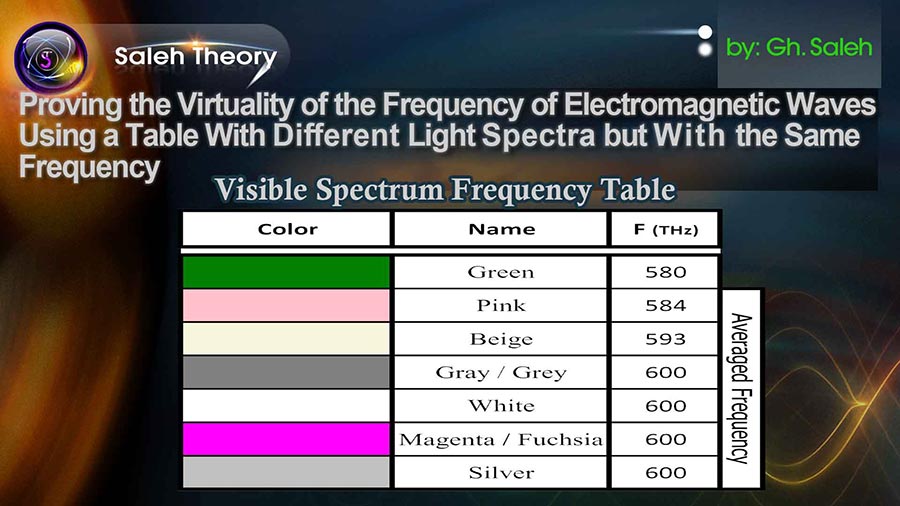
Proving the Virtuality of the Frequency of Electromagnetic Waves Using a Table with Different Light Spectra but With the Same Frequency
Considering the decomposed light from sunlight, there are 7 primary colors, each with a specific frequency and wavelength. However, when pure light sources are combined as ordered pairs—for example, if we combine pure red light with a frequency of 450 THz and pure violet light with a frequency of 750 THz in equal proportions—and wish to define a frequency for this combined light, we might calculate the average of the two frequencies, yielding 600 THz. Notably, the combination of red and violet produces a distinctive magenta color. Interestingly, while this frequency falls within the range of green light, the combined color does not resemble green in appearance. In other words, although the average frequency value of 600 THz corresponds to the green spectrum, the resultant magenta light is entirely distinct from green.
Therefore, it may be concluded that frequency acts as a secondary parameter in electromagnetic waves, whilst wavelength remains a primary parameter that does not change. We observe that various light combinations yield different colors despite having identical frequencies.

Result:
The above table clearly demonstrates that several different light spectra possess identical frequencies. Given these diverse color combinations, one may deduce that their wavelengths remain constant, whilst frequency emerges as a secondary and dependent parameter. The existence of different lights with identical frequencies indicates variations in their wavelengths. Indeed, in the fundamental formula:

Variations in velocity or wavelength combinations can increase or decrease the frequency, making it a dependent variable. To put it more precisely in physical terms, the wavelength determines the propagation pattern of an electromagnetic wave and has a fixed form and structure, whereas frequency lacks inherent stability. Instead, frequency transforms as the wavelength changes or when the speed approaches relativistic values (close to C), causing light frequencies to shift up or down.
References:
[1] Saleh, Gh. "A New Explanation for Frequency in Electromagnetic Waves 2025." Saleh Theory, 27 Mar. 2025, https://www.saleh-theory.com/article/a-new-explanation-for-frequency-in-electromagnetic-waves-2025
[2] Saleh, Gh. "A New Proof of the Constancy of Photon Mass Using Its Initial Energy." Saleh Theory, 06 Mar. 2025, https://www.saleh-theory.com/Article/a-new-proof-of-the-constancy-of-photon-mass-using-its-initial-energy
[4] Saleh, Gh. "New, Marvelous and Revolutionary Discoveries About Photon." Saleh Theory, 07 Sep. 2023, https://www.saleh-theory.com/article/new-marvelous-and-revolutionary-discoveries-about-photon
[9] Saleh, Gh. "Photon has a Constant Rest Mass!." Saleh Theory, 16 Mar. 2018, https://www.saleh-theory.com/article/photon-has-a-constant-rest-mass
[10] Saleh, Gh. "A Revolution in Light Theory." Saleh Theory, 11 Apr. 2017, https://www.saleh-theory.com/article/a-revolution-in-light-theory
 Download PDF
Download PDF Articles


